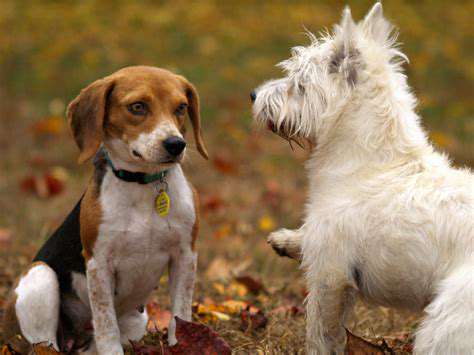Why socializing your dog is important for their health

Building Confidence Through Positive Interactions
Building a Strong Foundation
Proper socialization plays a pivotal role in canine development, molding their behavior and worldview. Introducing puppies to diverse people, animals, and settings early on establishes the framework for a self-assured, adaptable companion. Dogs exposed to varied experiences during their formative weeks typically demonstrate greater composure when facing new challenges.
The quality of these early encounters matters tremendously. Rather than overwhelming exposures, aim for pleasant, controlled interactions that create positive associations. The objective isn't to flood the puppy with stimuli but to carefully cultivate favorable impressions of different environments and beings.
Understanding Your Dog's Needs
Canine personalities vary dramatically across breeds and individuals. Recognizing your dog's unique temperament allows for customized socialization approaches. A Chihuahua's reaction to a Great Dane will naturally differ from how a Labrador might respond. This awareness enables owners to tailor experiences appropriately.
Timid puppies require special consideration. Identifying anxiety signals early permits adjustments to prevent traumatic experiences. Owner patience and calm reassurance prove indispensable for nervous canines.
Creating Positive Experiences
Reward-based training forms the bedrock of effective socialization. Immediate positive reinforcement for calm behavior reinforces desirable responses. Favorite treats, enthusiastic praise, or brief play sessions all serve as powerful motivators.
Prioritize enjoyable encounters over quantity. The aim is to link novelty with pleasure rather than distress. Consistency in your methods yields the best long-term results.
Introducing Controlled Environments
Begin in familiar, low-stimulus settings like your backyard before progressing to busier locations. Advance to more complex environments only when your dog shows readiness through relaxed body language.
New sensory experiences should be introduced incrementally. Watch for subtle stress signals - if observed, immediately retreat to a comfortable space. Never force interactions when your dog appears uncomfortable.
Socializing with Other Dogs
Structured playdates teach essential canine communication skills. Always supervise these meetings closely, intervening at the first sign of tension. Matching dogs by size and play style prevents most conflicts.
Encouraging Friendly Interactions with People
Well-rounded socialization includes positive human encounters across demographics. Reward calm greetings to encourage polite behavior. Varied human contact builds adaptability and confidence in unfamiliar social situations.
Gradually expose your dog to different human activities and appearances in manageable doses. This prevents overstimulation while promoting comfort with diversity.
Recognizing and Addressing Anxiety
Learn to interpret canine stress signals like excessive lip-licking, yawning, or avoidance behaviors. When these appear, promptly remove your dog from the triggering situation.
Counterconditioning techniques can help anxious dogs overcome fears. For persistent issues, consult an accredited behavior specialist for tailored guidance.
Preventing Behavioral Problems Through Exposure
Understanding the Importance of Exposure
Strategic exposure to diverse stimuli prevents future behavioral issues by teaching appropriate responses. Early, positive experiences shape a dog's worldview, reducing fear-based reactions. Properly socialized canines typically demonstrate greater adaptability in novel situations throughout their lives.
Introducing puppies to various sounds, surfaces, and scenarios builds resilience. This proactive approach significantly decreases the likelihood of phobias developing later. Remember - socialization encompasses far more than just dog-to-dog interactions.
Controlled and Gradual Introductions
The pacing of new experiences proves critical for successful socialization. Overwhelming a dog with too much too soon often backfires spectacularly. Instead, begin with brief, positive exposures in quiet settings, gradually increasing complexity as tolerance develops.
Imagine teaching a child to swim - you wouldn't start in the ocean during a storm. Similarly, dogs need structured, incremental challenges tailored to their individual progress.
Positive Reinforcement Techniques
Reward-based training methods yield superior results during socialization. Immediate positive feedback for desirable behaviors increases their recurrence. Punishment-based approaches often exacerbate anxiety, potentially creating new behavioral issues.
Identifying and Addressing Fear Responses
Learning canine body language helps owners recognize early stress signals. At the first sign of discomfort, calmly remove your dog from the situation. Later, reintroduce the stimulus at a lower intensity, pairing it with positive reinforcement.
Persistent fear responses may require professional intervention. Certified behaviorists can design customized desensitization protocols for challenging cases.
Building Confidence Through Consistent Exposure
Regular, positive experiences across various contexts steadily build canine confidence. Each successful interaction reinforces the dog's ability to handle novelty. Remember that progress isn't linear - some dogs need more repetition than others.
Creating a Safe and Predictable Environment
Consistent routines provide the security dogs need to venture outside their comfort zones. Clear expectations and reliable responses from owners reduce anxiety during new experiences. This stability allows dogs to focus on learning rather than worrying.
Maintaining Healthy Relationships with Other Animals

Understanding the Foundation of Healthy Relationships
Successful interspecies relationships require mutual respect and clear communication. Building trust between animals demands patience and careful observation of body language. Never force interactions - let animals approach each other at their own pace.
Respecting individual boundaries prevents most conflicts. Watch for subtle signals like stiffening or avoidance, which indicate discomfort requiring intervention.
Open and Honest Communication
Animals communicate primarily through body language. Learning to interpret these signals prevents misunderstandings. Supervise all initial interactions closely, ready to separate animals if tensions arise.
Active Listening and Empathy
Pay attention to all participants' comfort levels during animal introductions. What seems playful to one species might terrify another. Adjust the environment to accommodate each animal's needs.
Conflict Resolution Strategies
Prevent most conflicts through proper introductions and gradual acclimation. If aggression occurs, separate animals immediately and consult a professional. Never punish animals for natural reactions - instead, modify the situation.
Setting and Respecting Boundaries
Provide safe spaces where each animal can retreat when needed. Forced proximity often escalates tensions rather than resolving them. Respect individual preferences for interaction frequency and intensity.
Maintaining Individuality and Personal Growth
Allow each animal to maintain its unique personality and preferences. Don't expect different species to conform to unnatural behaviors. Celebrate their differences while fostering peaceful coexistence.
Long-Term Benefits of a Well-Socialized Dog

Strengthening Social Connections
Socialized dogs enrich human lives through shared activities. Well-adjusted canines facilitate owner social connections at parks, training classes, and community events. These interactions benefit both species' emotional wellbeing.
Improved Mental Well-being
Confident dogs reduce owner stress through reliable behavior. The companionship of a stable, socialized dog provides consistent emotional support. Their predictable responses create a calming presence.
Enhanced Physical Health
Social dogs encourage regular exercise through walks and outdoor activities. Owners of well-socialized dogs often maintain more active lifestyles. This mutual activity benefits both canine and human health.
Increased Resilience
Dogs comfortable with novelty adapt better to life changes. Socialization prepares dogs to handle moves, travel, and routine disruptions with minimal stress. This adaptability makes them ideal companions for dynamic lifestyles.
Greater Life Satisfaction
Fewer behavioral issues mean more enjoyable companionship. Socialized dogs participate more fully in family life and community activities. This integration enhances quality of life for both species.
Boosted Self-Esteem
Successfully socializing a dog builds owner confidence. Positive training experiences strengthen the human-canine bond. This mutual understanding fosters pride in both parties.
Reduced Stress and Anxiety
Predictable canine behavior lowers household tension. Well-socialized dogs create calmer home environments through their stable temperaments. Their relaxed demeanor often rubs off on human companions.
- Decoding Canine Behavior: A Comprehensive Guide
- Decoding Human Actions: A Comprehensive Guide to Behavioral Insights
- Tips for calming a stressed or anxious dog
- How to improve communication with your dog
- Socialization exercises for dogs
- Games and activities to keep your dog entertained
- How to train your dog to sit, stay, and come
- Real stories of dogs recovering from severe illness
- How to help your dog interact well with other pets
- The best cooling mats for dogs during hot weather
- Preparing your dog for grooming during summer
- Calming products to help anxious dogs relax